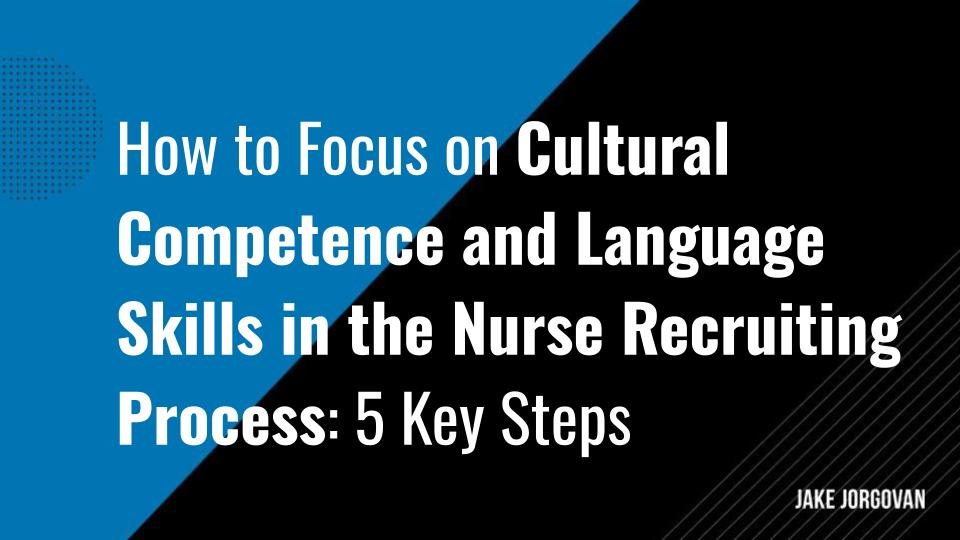5 Steps to Improve Cultural Competence and Language Skills in Nurse Recruiting
Recruiting skilled nurses goes beyond clinical expertise; it's about cultural competence and language proficiency. These skills are critical for delivering quality care in a globalized healthcare environment.
Yet, many organizations overlook them in the hiring process.
This article outlines five essential steps to ensure your recruitment strategy prioritizes cultural competence and language skills.
Following these steps allows you to attract and retain nurses who excel clinically and connect deeply with diverse patient populations.
Let's dive into how you can refine your nurse recruitment to meet these critical demands.
5 Steps for Recruiting Nurses with a Focus on Cultural Competence and Language Skills
1) Define the Specific Cultural Competencies and Language Skills Required for the Role
Understanding your cultural needs and language requirements is key to recruiting nurses who will excel in your healthcare setting. The specifics of these needs can directly impact patient outcomes, staff satisfaction, and overall organizational effectiveness. Get this right, and you’ll build a team that meets your patients’ expectations and also reflects the diversity and inclusivity your organization stands for. Here’s how to do it:
Identify Patient Demographics: Start by analyzing the cultural and linguistic backgrounds of the populations your facility serves. This ensures that the competencies and skills you define are directly relevant to your patient base.
Consult Key Stakeholders: Engage with department heads, senior nurses, and HR professionals. Their insights will help refine the cultural competencies and language skills necessary to deliver high-quality care.
Map Out Core Competencies: Clearly define cultural competence in practice. List the specific skills, such as bilingual communication, understanding cultural health practices, or navigating religious sensitivities, that are non-negotiable for the role.
Create Assessment Criteria: Develop measurable criteria to evaluate these competencies during the recruitment process. This might include language proficiency tests, scenario-based interviews, or role-playing exercises focused on cultural sensitivity.
Document and Standardize: Document these requirements and integrate them into your recruitment policies. Standardization helps maintain consistency across hiring processes and ensures that every candidate is assessed on the same critical criteria.
Insider Tip: We’ve found that aligning cultural competencies with ongoing staff training programs boosts retention rates. Once you’ve identified the needed skills, develop a training module addressing the gaps and strengths observed during recruitment. This strategy reinforces the competencies and empowers your team to improve continuously.
2) Partner with Diverse Community Organizations and Networks to Reach Qualified Candidates
Establishing strong connections with diverse communities is crucial for recruiting nurses who bring cultural competence and language skills to your organization. These networks serve as bridges to candidates who already understand the unique needs of your patient population. Targeting these communities widens your talent pool and enhances your ability to deliver culturally sensitive care. Here’s how to get started:
Identify Relevant Community Organizations: Research and list organizations, cultural associations, and community centers that align with your patient base's cultural and linguistic needs. This step ensures that you reach candidates with the right background and skills.
Build Genuine Relationships: Engage with leaders and key members of these communities. Regularly attend their events, offer to collaborate on health initiatives, and demonstrate a commitment to their causes. These relationships increase your visibility and trust within these communities.
Leverage Community Platforms: Post job opportunities in newsletters, social media groups, and community bulletin boards. Tailor your messaging to resonate with the cultural values and professional aspirations of these communities' members.
Host Targeted Recruitment Events: Organize job fairs or open houses in collaboration with community organizations. Offer on-the-spot interviews, cultural competence workshops, or language skills assessments to attract qualified candidates.
Track and Adjust Your Efforts: Monitor the effectiveness of your partnerships through metrics such as the number of applicants and hires from these communities. Adjust your strategies based on this data to ensure continued success.
Insider Tip: We’ve observed that providing a dedicated point of contact within your organization for each community organization can significantly streamline communication. This liaison should understand the community's specific cultural nuances. This ensures more effective engagement and recruitment outcomes.
3) Incorporate Cultural Competence Assessments into the Interview and Selection Process
Integrating cultural competence assessments into your interview process is essential for ensuring that you select candidates who meet clinical standards and excel in providing culturally sensitive care. In this step, you filter candidates based on the skills and attributes most critical to your organization’s success. Done right, it will align your hiring process with the specific needs of your patient population and the values of your healthcare facility. Follow the steps below to implement this method:
Design Scenario-Based Questions: Develop interview questions that require candidates to respond to real-world scenarios involving diverse cultural situations. Focus on how they navigate cultural sensitivities, communicate across language barriers, and adapt care plans to respect cultural practices.
Include a Language Proficiency Test: If language skills are crucial, incorporate a language assessment into your interview process. This could be a formal test or an informal conversation in the required language to gauge fluency and communication effectiveness.
Involve a Culturally Diverse Panel: Assemble an interview panel that reflects your patient base's and team's cultural diversity. This ensures that the evaluation of responses is well-rounded and free from cultural bias.
Evaluate Non-Verbal Communication: Respond to the candidate’s non-verbal cues during the interview. These can provide insights into their ability to engage with patients from different cultural backgrounds, particularly regarding respect, empathy, and cultural awareness.
Score and Compare: Evaluate each candidate's responses using a standardized scoring system. Compare scores across candidates to objectively determine who best meets your cultural competence criteria.
Insider Tip: We’ve found that role-playing exercises where candidates interact with simulated patients can reveal much about their practical cultural competence. Incorporating this into your process tests their theoretical knowledge and ability to apply it under pressure and offers you a deeper insight into their suitability for the role.
4) Offer Targeted Training Programs to Enhance Cultural Competence and Language Skills
Offering targeted training programs is a proactive way to enhance your nursing staff's cultural competence and language skills. Even when you recruit candidates with strong foundations, continuous development ensures their skills stay relevant and practical. This approach benefits your organization by creating a more adaptable and culturally sensitive workforce, better equipped to meet the diverse needs of your patients. Here’s how to use this strategy:
Assess Training Needs: Begin by thoroughly assessing your current team’s cultural competence and language skills. Identify areas where gaps exist or enhancements could significantly improve patient care.
Develop Customized Training Modules: Design training programs that address the identified gaps. Include modules on cultural sensitivity, specific language skills relevant to your patient demographics, and best practices for delivering culturally competent care.
Incorporate Practical Scenarios: Use case studies, role-playing, and simulations to make the training more practical and relatable. These exercises help nurses apply their knowledge in a controlled environment, improving retention and effectiveness.
Schedule Regular Refreshers: Plan ongoing training sessions rather than one-time events. This ensures that your staff continuously refines their skills and stays updated on any new practices or cultural nuances that may arise.
Measure Impact and Adjust: After implementing the training, evaluate its impact through patient feedback, staff self-assessments, and performance reviews. Use this data to fine-tune your programs, ensuring they remain relevant and impactful.
Insider Tip: In our experience, involving patients in the training process as guest speakers can provide valuable real-world insights and emphasize the importance of cultural competence. This enriches the training and fosters a stronger connection between your nursing staff and the community they serve.
5) Implement a Mentorship Program to Support Nurses in Developing and Applying These Skills
Implementing a mentorship program designed to support the development of cultural competence and language skills is a powerful way to embed these critical capabilities into your nursing staff. This approach goes beyond traditional training and offers nurses personalized guidance and real-world application. Mentorship accelerates learning and fosters a collaborative environment where cultural competence is taught and practiced daily. Here’s how to do it:
Pair Wisely: Select mentors who possess strong cultural competence and language skills and embody your organization's values and practices. Match them with mentees based on shared cultural backgrounds or language abilities to maximize the program's effectiveness.
Set Clear Objectives: Establish specific goals for the mentorship, such as improving language proficiency, enhancing understanding of cultural nuances, or developing strategies for culturally sensitive patient interactions. These objectives should guide the relationship and provide measurable outcomes.
Encourage Shadowing: Allow mentees to observe their mentors during patient interactions. This real-time learning experience helps mentees understand how cultural competence is applied in various clinical scenarios, reinforcing their formal training.
Facilitate Regular Feedback: Create a structured process for ongoing feedback between mentors and mentees. Regular check-ins help address challenges, celebrate progress, and adjust goals as needed, ensuring the mentorship remains focused and productive.
Document Progress: Record each mentee’s development throughout the program. This documentation provides valuable insights into the program’s impact and can inform future training and development strategies.
Insider Tip: We suggest incorporating cross-cultural peer reviews within the mentorship program. This enhances accountability and reinforces learning. Encourage mentees to present case studies or experiences to a broader team for feedback. This practice builds confidence and spreads cultural competence across your entire nursing staff.
Enhance Your Recruitment Process by Focussing on Cultural Competence
Cultural competence and language skills are critical yet often overlooked in nurse recruitment.
Ignoring these aspects can lead to miscommunication and compromised patient care.
You can transform your recruitment process by following the five key steps we've outlined.
The solution is clear: focus on these essential skills to build a stronger, more inclusive healthcare team.
Implement these strategies and see the difference in patient outcomes and staff satisfaction.































